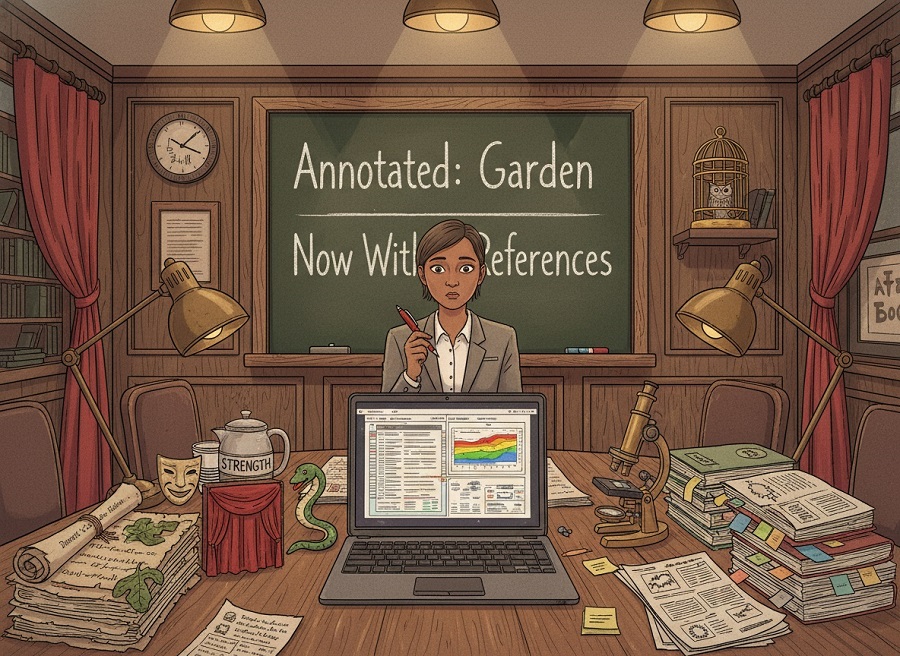From Eden to Evidence: Editing the Origin Story
Welcome to the editorial meeting nobody asked for: the Origin Story Revision Committee. On the left, a solemn pile of parchment labeled “Director’s Cut: Garden Edition” (leaves conveniently supplied). On the right, a stack of peer-reviewed journals with Post-it notes protruding like tiny flags of fact. In the middle, a beleaguered intern holding a red pen and wondering whether to use Track Changes or a geological timescale.
Agenda item one: tone. The Garden script reads beautifully—metaphors, moral arcs, and a very dramatic serpent with impeccable timing. It’s great theater. But the Science Desk recommends a few adjustments: replace “instantaneous creation” with “gradual emergence (see: billions of years),” swap the deus ex machina for natural mechanisms, and add a subplot about small, stubborn cells that somehow refuse to be dramatic but do produce reproducible data.
Agenda item two: continuity. The fossils keep showing up like uninvited guests with inconveniently accurate résumés. “We appreciate your enthusiasm,” the Myth Department notes, “but could you at least RSVP before branching into phylogenetic trees?” Meanwhile, carbon dating slides across the table like an awkward gif: “Hi. I’m your timeline.”
Agenda item three: citations. “In the margin where you wrote ‘and then a voice spoke,’ could you add a footnote?” asks an earnest editor. “Perhaps: ‘audible to at least three witnesses; corroborating evidence pending.’” The Myth Department suggests adding a line about the poetic economy of myth—how concise stories serve communal meaning better than a thousand charts. The Science Desk counters with charts that refuse to look poetic but insist on being reliable.
Break time: tea is served. The moderator suggests empathy for all narratives — they all started as ways to put bewilderment into words. A senior editor whispers, “Keep the story. Add the evidence. Footnote the miracle. And for the love of peer review, don’t let the serpent ghostwrite the appendix.”
Closing remarks: the new edition will be labeled “Annotated: Garden—Now With References.” It will feature a director’s commentary by paleontologists and theologians who both agree on at least one thing: humans are remarkably good at storytelling. Whether you prefer the theatrical rendition or the annotated anthology, both versions can sit on the same shelf—one with a glossy cover, the other with a DOI.
Moral (wry): Stories explain why. Data explains how. A good edit keeps both, and the intern finally uses Track Changes — because even origin stories appreciate constructive criticism.
এডেন থেকে প্রমাণ: উৎপত্তি কাহনী সম্পাদনা
স্বাগতম সেই সম্পাদনা বৈঠকে যেটা কারো অনুরোধ ছিল না: উৎপত্তির কাহিনী পুনরাবৃত্তি কমিটি। বাঁদিকে ঝাঁকুনিতে রাখা পরত-কাগজে লেখা — “ডিরেক্টর’স কাট: বাগান সংস্করণ” (পাতা প্রস্তুত রয়েছে)। ডানদিকে স্তূপ করা পিয়ার-রিভিউড জার্নাল, পোস্ট-ইটের সরু পতাকা একে অন্যকে চুম্বক মতো টেনে আনে। মাঝখানে এক ক্লান্ত ইন্টার্ন লাল কলম ধরে—Track Changes ব্যবহার করবেন নাকি ভূতাত্ত্বিক সময়তালিকা?
এজেন্ডা এক: ভাষা। বাগানের স্ক্রিপ্ট দারুণ—রূপক, নৈতিক বাঁক এবং এক নাটকীয় সাপের টাইমিং নিখুঁত। থিয়েটারের মতো। তবে বিজ্ঞান বিভাগের পরামর্শ আছে: “তৎক্ষণাৎ সৃষ্টি” বাদ দিয়ে বসান “ধীরে ধীরে উদ্ভব (বছর-সহস্রাধিক দেখুন),” দেবতা-মেশিনারিয়া বদলে দিন প্রাকৃতিক প্রক্রিয়ায়, আর সাবপ্লট যোগ করুন ছোট কিন্তু অনমনীয় কোষদের নিয়ে—তারা নাটকীয় নয়, তবে পুনরাবৃত্তি-যোগ্য ডেটা তো দেয়।
এজেন্ডা দুই: ধারাবাহিকতা। জীবাশ্মগুলো অনিচ্ছাকৃত অতিথিদের মতো এসে বসে, অপ্রত্যাশিত রেজুমে নিয়ে। “আপনার আগ্রহের আমরা কদর করি,” মিথ বিভাগ জানায়, “কিন্তু phylogenetic tree-তে শাখা বাড়ানোর আগে RSVP করলে ভালো হতো।” একে দিকে কার্বন-ডেটিং টেবিলের উপর সরে এসে বলে, “হাই। আমি আপনার টাইমলাইন।”
এজেন্ডা তিন: সূত্র। “যেখানে লিখেছেন ‘তারপর একটি কণ্ঠ বলল’—ওই দাগে একটি ফুটনোট দেবেন কি?” এক আন্তরিক সম্পাদক জিজ্ঞেস করে। “সম্ভবত: ‘কমপক্ষে তিনজন সাক্ষীর কাছে শ্রোতযোগ্য; সমর্থনকারী প্রমাণ প্রযোজ্য হলে আপডেট করা হবে।’” মিথ বিভাগ বলে, মিথের কাব্যিক অর্থ-অর্থনীতি যোগ করুন—এক হাজার চার্টের চেয়ে একটি সংক্ষেপিত গল্প শ্রেণির মানে দেয়। বিজ্ঞান বিভাগ চার্ট তুলে ধরে—যেগুলো কাব্য নয়, তবে নির্ভরযোগ্য হওয়ার ব্যাপারে মোটেই আপস করে না।
বিরতি-কাল: চা বিতরণ। মডারেটর সব বর্ণনার প্রতি সহানুভূতি রাখার পরামর্শ দেন—সবকিছুই মানুষের হতবুদ্ধি বোঝানোর উপায় হিসেবে শুরু হয়েছিল। একজন প্রবীণ সম্পাদক ফিসফাস করে বললেন, “গল্প রাখো। প্রমাণ যোগ করো। অলৌকিক ঘটনার পাশে ফুটনোট বসাও। আর—দাঁত টেনে বলি—সাপকে অ্যাপেন্ডিক্স লেখার অনুমতি দিও না।”
সমাপনী মন্তব্য: নতুন সংস্করণে লেখা থাকবে “অ্যানোটেটেড: বাগান—এখন রেফারেন্স সহ।” এতে থাকবে পরিচালকীয় কমেন্টারি—প্যালিওনটোলজিস্ট ও ধর্মতত্ত্ববিদেরা দু’জনেই অন্তত একটিতে একমত: মানুষ গল্প বলার ক্ষেত্রে অনবদ্য। থিয়েট্রাল সংস্করণই বা অ্যানোটেটেড সংকলন—উভয়ই একই তাকেই বসতে পারে—একটির পালিশ কভার থাকবে, অন্যটির DOI।
মোরাল (হাস্যরসাত্মক): গল্প বলে কেন। ডেটা বলে কিভাবে। ভালো সম্পাদনা দুটোই রাখে, আর ইন্টার্ন শেষে Track Changes চালিয়ে দেয়—কারণ উৎপত্তির কাহিনীও গঠনমূলক সমালোচনাকে পছন্দ করে।

